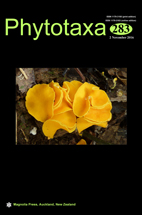Abstract
The trebouxiophycean genus Phyllosiphon contains unique green algae that thrive as endophytic parasites in the leaves of various members of the Araceae. The DNA sequences of the parasitic populations were originally acquired from infected leaves of subtropical Arisarum vulgare. However, several previous studies showed that the members of the Phyllosiphon clade also occur as free-living algae on various subaerial substrates across Europe. Phyllosiphon infection was also observed on the leaves of the temperate genus Arum, but no molecular data was available for these parasites. We recently found these parasites at a single sub-Mediterranean locality. These algae were genetically different from those previously obtained from Arisarum leaves on the basis of their 18S rDNA and rbcL gene sequences. In the present study, we describe this organism as a new species, Phyllosiphon ari. Phylogenetic differentiation of Phyllosiphon taxa, correlated with host specificity to different genera of the Araceae, suggests concerted host-pathogen co-evolution driving species diversification within this peculiar green algal lineage.

